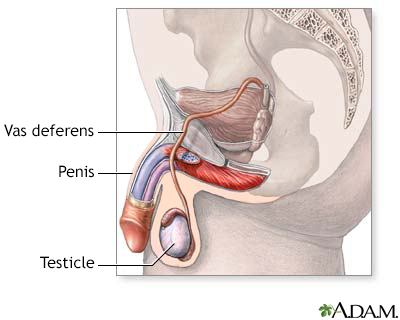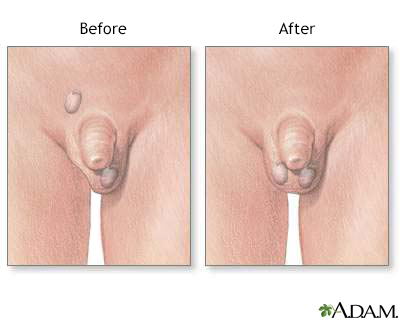Pregnancy SmartSiteTM
Cryptorchidism; Empty scrotum - undescended testes; Scrotum - empty (undescended testes); Monorchism; Vanished testes - undescended; Retractile testes DefinitionUndescended testicle occurs when one or both testicles fail to move into the scrotum before birth. CausesMost of the time, a boy's testicles descend into the scrotum by the time he is 6 months old. Undescended testicles are common in infants who are born early. The problem occurs less in full-term infants. Some babies have a condition called retractile testes and the health care provider may not be able to find the testicles. In this case, the testicle is normal, but is pulled back out of the scrotum by a muscle reflex. This occurs because the testicles are still small before puberty. The testicles will descend normally at puberty and surgery is not needed. Testicles that do not naturally descend into the scrotum are considered abnormal. An undescended testicle is more likely to develop cancer, even if it is brought into the scrotum with surgery. Cancer is also more likely in the other testicle. Bringing the testicle into the scrotum can improve sperm production and increase the chances of good fertility. It also allows the provider to do an exam for the early detection of cancer. In other cases, no testicle may be found, even during surgery. This may be due to a problem that occurred while the baby was still developing before birth. SymptomsMost of the time there are no symptoms other than the absence of the testicle in the scrotum. (This is called an empty scrotum.) Exams and TestsAn exam by the provider confirms that one or both of the testicles are not in the scrotum. The provider may or may not be able to feel the undescended testicle in the abdominal wall above the scrotum. Imaging tests, such as an ultrasound or CT scan, may be done. TreatmentIn most cases, the testicle will descend without treatment during the child's first year. If this does not occur, treatment may include:
Having surgery early may prevent damage to the testicles and avoid infertility. An undescended testicle that is found later in life may need to be removed. This is because the testicle is not likely to function well and could pose a risk for cancer. Outlook (Prognosis)Most of the time, the problem goes away without treatment. Medicine or surgery to correct the condition is successful in most cases. Once the condition is corrected, you should have routine testicle exams by your provider. In about 50% of males with undescended testicles, the testicles cannot be found at the time of surgery. This is called a vanished or absent testis. As stated earlier, it may be due to something while the baby was still developing during pregnancy. Possible ComplicationsComplications may include:
When to Contact a Medical ProfessionalContact your child's provider if he appears to have an undescended testicle. ReferencesBarthold JS, Hagerty JA. Etiology, diagnosis, and management of the undescended testis. In: Partin AW, Domochowski RR, Kavoussi LR, Peters CA, eds. Campbell-Walsh-Wein Urology. 12th ed. Philadelphia, PA: Elsevier; 2021:chap 46. Chung DH. Pediatric surgery. In: Townsend CM Jr, Beauchamp RD, Evers BM, Mattox KL, eds. Sabiston Textbook of Surgery. 21st ed. St Louis, MO: Elsevier; 2022:chap 67. Elder JS. Disorders and anomalies of the scrotal contents. In: Kliegman RM, St. Geme JW, Blum NJ, Shah SS, Tasker RC, Wilson KM, eds. Nelson Textbook of Pediatrics. 21st ed. Philadelphia, PA: Elsevier; 2020:chap 560. Robertson RP. Testicular dysgenesis syndrome and testicular tumors. In: Robertson RP, ed. DeGroot's Endocrinology. 8th ed. Philadelphia, PA: Elsevier; 2023:chap 115. | |
| |
Review Date: 7/1/2023 Reviewed By: Kelly L. Stratton, MD, FACS, Associate Professor, Department of Urology, University of Oklahoma Health Sciences Center, Oklahoma City, OK. Also reviewed by David C. Dugdale, MD, Medical Director, Brenda Conaway, Editorial Director, and the A.D.A.M. Editorial team. The information provided herein should not be used during any medical emergency or for the diagnosis or treatment of any medical condition. A licensed medical professional should be consulted for diagnosis and treatment of any and all medical conditions. Links to other sites are provided for information only -- they do not constitute endorsements of those other sites. No warranty of any kind, either expressed or implied, is made as to the accuracy, reliability, timeliness, or correctness of any translations made by a third-party service of the information provided herein into any other language. © 1997- A.D.A.M., a business unit of Ebix, Inc. Any duplication or distribution of the information contained herein is strictly prohibited. | |

 Male reproductive ...
Male reproductive ... Male reproductive ...
Male reproductive ... Before and after t...
Before and after t...
